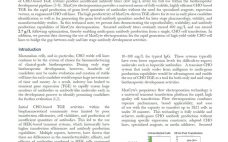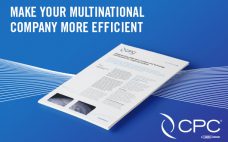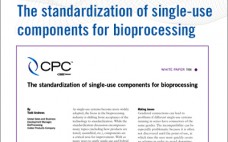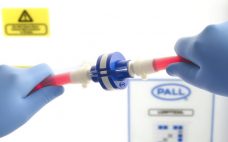Despite advances in transfection methods and culture optimization, many CHO-based TGE systems produce insufficient antibody titers (low mg/L level) for full use within biotherapeutic development pipelines. The high productivity of MaxCyte-driven transient gene expression allows for its use in early phase candidate identification as well as for generating the gram-level antibody quantities needed for later stage pharmacology, stability and manufacturing studies. In this white paper, data are presented demonstrating the reproducibility, scalability and antibody production capabilities of MaxCyte Flow Electroporation™…
BPI White Papers
Implementing Global Best Practices and Technology Specifications for Single-Use Systems
As global markets become more and more important, so does global manufacturing. But when your company has several manufacturing sites across the world it can be difficult to streamline efforts, manage costs and share valuable information. Our recent white paper “Implementing global best practices and technology specifications for single-use systems” tackles the issues of multinational drug manufacturing and offers several best practices that can help you cut your time to market, lower probability of process troubleshooting during start-up and decrease…
Case Studies Using Mass Spectrometry to Characterize a Protein-Hapten Drug Substance
Clients often come to us with protein conjugation process needs that can require development of new and innovative methods to assure process validation for conformance manufacturing. Our staff utilizes state-of-the art technologies and instrumentation for a wide range of protein drug manufacturing challenges. These scientists provide the expertise and experience needed to develop accurate and highly reliable assay methods designed specifically to assure successful conformance manufacturing of their protein-hapten or protein-drug conjugate. This white paper illustrates just one example of…
Use of the ambr®250 in Combination with High-Throughput Design and Analysis Tools for Rapid, Scalable USP Development
There have been many recent advances in high throughput (HT) technologies for upstream development, enabling processes to be developed in a fraction of the time compared with conventional methods. However, when applying this technology to biotherapeutic drug development, the suitability of the systems for developing large scale manufacturing processes and meeting regulatory demands needs to be demonstrated and ensured. Inclusive approaches encapsulating platform expression systems and fermentation technologies, parallel bioreactor systems, high throughput analytics and sophisticated design and data handling…
Extractable and Leachables Studies: Designed and Performed to Meet all Intended Needs
Since the FDA released their Container Closure Systems for Packaging Human Drugs and Biologics guidance in 1999, evaluation of final packaging components for extractables and leachables has become the expectation within the industry. Additionally, the increase in the use of single-use systems in manufacturing has drawn scrutiny as another potential source of extractables and leachables. Extractables are compounds that can be extracted from a product contact material under exaggerated conditions such as elevated temperatures, extended storage times, or exposure to…
Filling Industry Gaps with Dedicated Cell Therapy Fluid Transfer Sets
For years, availability has cornered cell therapy manufacturers into utilizing transfer sets intended for other industries and applications. These transfer sets or accessory sets are not designed for cell therapy, and therefore lack key requirements, essential to clinical and commercial manufacturing. Many current personalized cell therapies are highly manual in practice, and require numerous ancillary components and handling steps. Modifications to these processes further complicate this inherently challenging process. These deviations impact the reproducibility of the manufacturing platform, as well…
Characterization and Engineering Performance of the Allegro™ STR 2000 Single-Use Stirred Tank Bioreactor
Process performance in bioreactors is strongly influenced by the efficiency of bulk fluid mixing and the oxygen mass transfer coefficient (kLa). The success of traditional stainless steel STR systems lies in their direct impeller driven agitation that can deliver a wide range of specific power inputs to the fluid. The Allegro™ range of single-use stirred tank bioreactors has adopted this direct driven impeller technology, which allows a wide range of specific power inputs to be achieved. In addition, modifications to…
The Standardization of Single-use Components for Bioprocessing
As single-use systems become more widely adopted, the focus in the bioprocessing industry is shifting from acceptance of the technology to standardization. While the standardization discussion encompasses many topics (including how products are tested, assembled, etc.), components are a critical area for improvement. With so many ways to apply single-use and hybrid bioprocessing systems, organizations must take action to standardize equipment in order to streamline operations and help reach the full potential of the technology. This paper discusses standardization in…
New Genderless Sterile Connection Technology – A Quality By Design (QbD) Approach For Greater Sterility Assurance From Manufacturing To Use
Single-use pre-sterilized systems can potentially offer a higher level of sterility assurance and a lower risk of product contamination by eliminating some of the operational procedures of traditional processing. The importance of this benefit was highlighted by the FDA’s product recalls in 2015 where 78% of recalls were attributed to lack of sterility assurance or to contamination of the drug product, with the primary reason being failure to follow written procedures. A key requirement for multi-component, single-use sterile systems is…
Pegasus™ Prime: Robust Retention after Pressure Interruptions (Stop and Start)
Virus filtration is a vital part of the viral clearance strategy in bioprocesses. In filtration, size exclusion mechanisms are orthogonal to other inactivation or removal techniques and target the physical dimensions of the virus to achieve a high degree of virus reduction. Any flow or pressure interruption during filtration has been shown to increase the risk of virus passage. This application note reviews the PegasusTM Prime virus removal filters and demonstrates robust, high viral clearance in the presence of prolonged…










